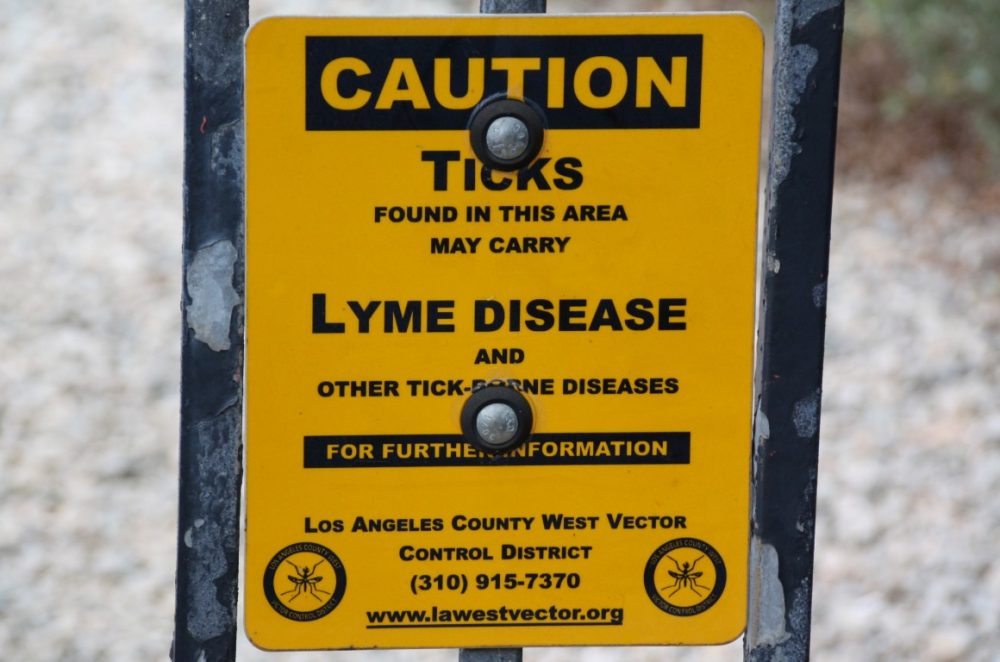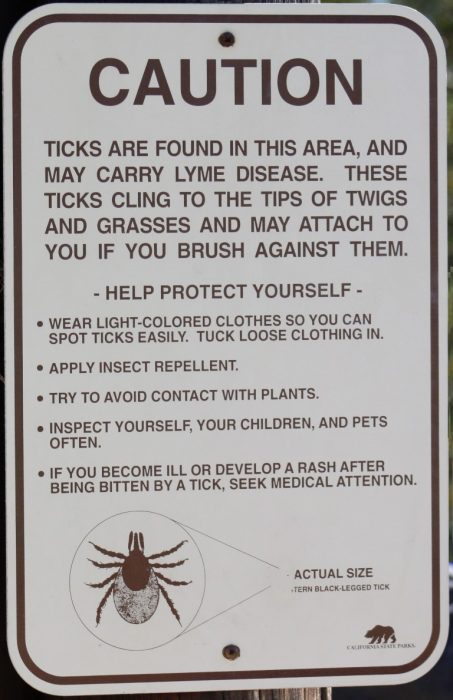Ticks at California Beaches

It’s pretty common to see the words ticks and Lyme Disease used in the same sentence. Unfortunately, like cancer almost everyone knows someone who has contracted Lyme Disease (the author of this article battled Lyme for 4.5 years). Several studies show that this problem is getting worse on the California Coast. This frustrating disease is caused by a bacteria that is carried by ticks and transmitted to humans through their bite.
To make matters worse ticks are tiny arachnids (eight-legged bugs) that are hard to see or feel on the body. Even the nymphs (baby ticks) can carry the bacteria and spread it to humans and they are just a millimeter in size or less (about the size of a poppy seed or this period . ).
How do ticks get onto humans
Ticks are found on vegetation so the highest risk is when brushing up against tall grasses, bushes, and trees along a trail or near a beach. They are NOT found in the sand on a beach so going to a beach is not a risk if you can avoid contact with vegetation on the way to the sand.
Where are ticks on the California Coast
It’s not surprising to learn that ticks are near the ocean since they thrive in moist conditions. All of California’s coastal counties have habitats that are home to dangerous ticks. Counties north of San Francisco tend to have the highest concentration of Lyme carrying ticks (it’s wetter up there). This includes Marin County (worst), then Sonoma, Mendocino, Humboldt, and Del Norte Counties. In Central California Santa Cruz County is considered the worst spot, then San Mateo, Monterey (including Big Sur), San Luis Obispo, Santa Barbara, and Ventura Counties. Southern California has the lowest risk as it’s much drier there, but San Diego, Orange County, and Los Angeles County all have places where ticks can be found, especially on the Palos Verdes Peninsula.
When are ticks most common
The risk of getting a tick on your body is highest in the spring and summer months when the nymphs are most prevalent. However any time of year there is a risk.
How to avoid ticks
Avoiding contact with vegetation is best, but if you are hiking or biking trails, or simply walking to a beach and must contact vegetation, it’s best to check your clothes right away. Wearing light colored pants (like light khaki hiking pants) and a light colored shirt and socks helps as ticks are usually a darker color (nymphs can be light colored unfortunately). After getting home, wash and dry your clothes on hot asap. If you took a dog on your trip, check them closely as they can get Lyme Disease as well or transfer ticks to you.
How to check for ticks
After getting your clothes off you’ll want to check your body everywhere, but take more time with your hair, armpits, and private parts. Rub your arms, legs, back, and front to feel for a hard thing like a piece of sand, especially one that won’t move (could be an attached tick). If you have a magnifying glass or app on your phone that can help. Showering and drying your body thoroughly is a good idea too.
What to do if bitten by a tick
If you have pointy tweezers try to grab the tick as close to the head as possible and pull slowly straight out (squeezing the body can force their stomach contents into you). Without tweezers, use a knife or other thin object and put it under the body to grab it. Save the tick in a bag for viewing or testing later if necessary. You should visit a doctor as soon as possible and bring the tick and try to calculate how long it was attached to your body (if more than 6 hours you could be at risk). Not all ticks have the Lyme Disease causing bacteria and the risk varies from place to place (more info here). If you get a red rash or a somewhat circular ring around the bite you probably have Lyme so get on antibiotics asap (no rash or no ring doesn’t mean you did not get infected). The most common antibiotic for the initial treatment is doxycycline which is a relatively safe antibiotic so take it for at least a month (don’t let your doctor tell you 2 weeks is enough as this advice is outdated in the medical world). You’ll have to stay out of the sun while on this drug and you must take gobs of pre and probiotics to protect your gut. If this treatment doesn’t get rid of it, you could be in for a difficult and costly long-term treatment. More rotating antibiotics and countless experimental treatments have been claimed to be successful including anti-inflammatory oxygen treatments (like EWOT or LiveO2). Chronic Lyme Disease is a real thing with strange and diverse symptoms – it’s not something you want to deal with.
Other tick-borne diseases
Lyme Disease isn’t the only debilitating condition you can get from a tick bite. Anaplasmosis, Babesiosis, Ehrlichiosis, and Rocky Mountain Spotted Fever are just some of the crud that are commonly associated with ticks. For that reason you should do your best to avoid all species of ticks during every time of year.

